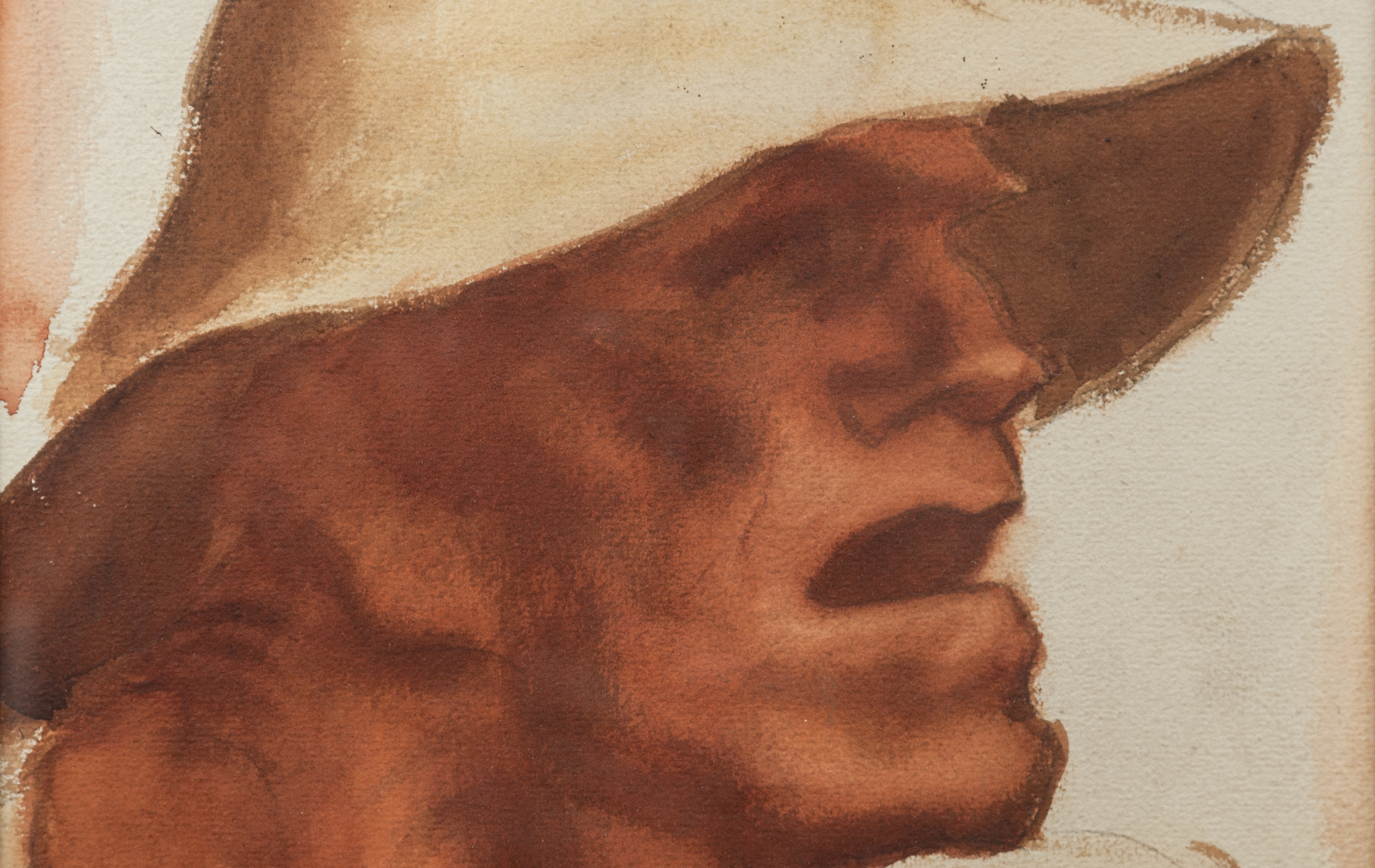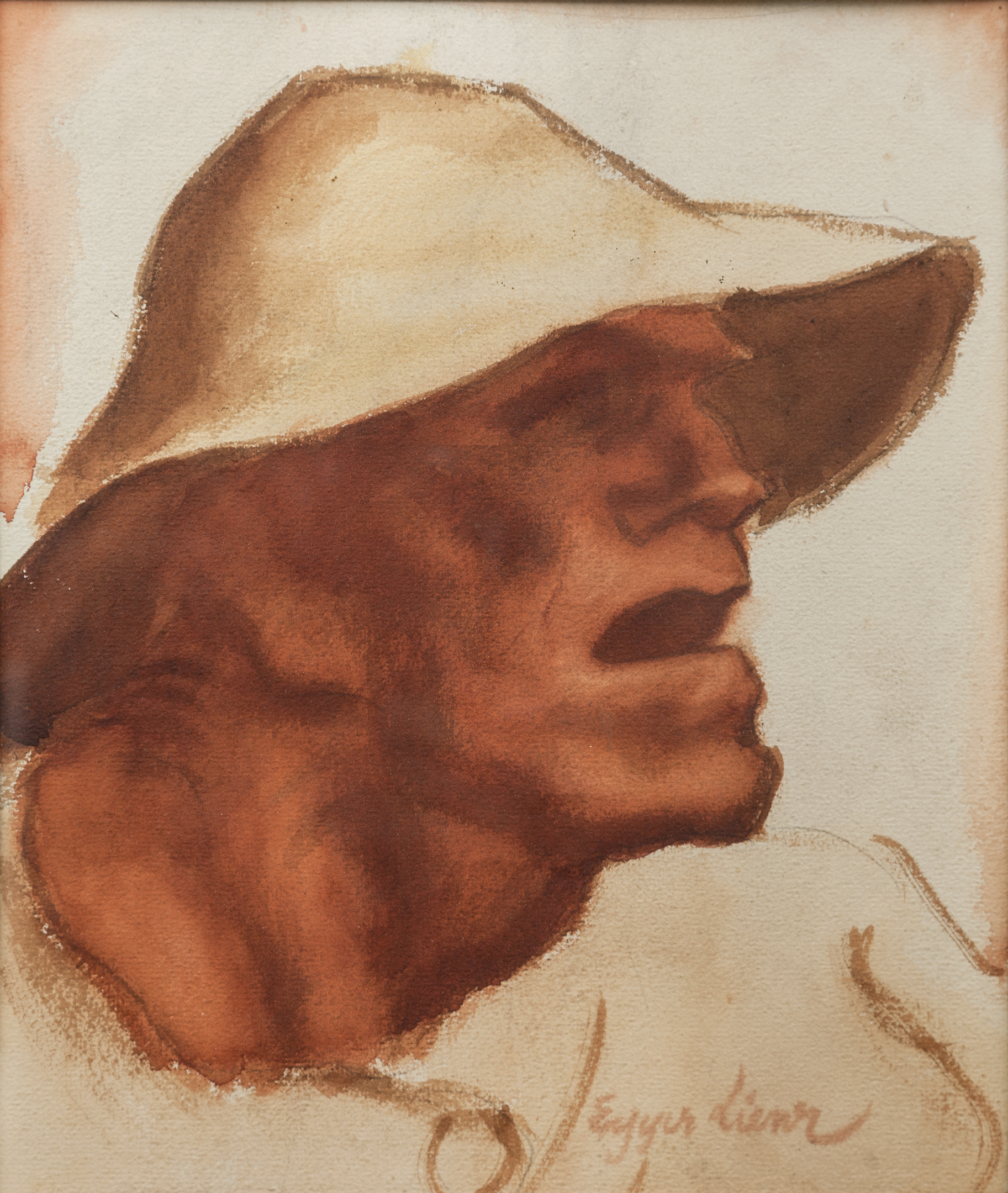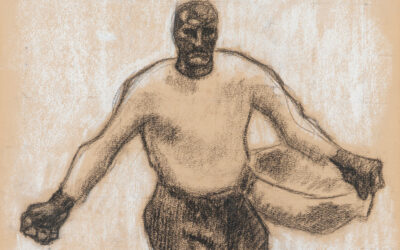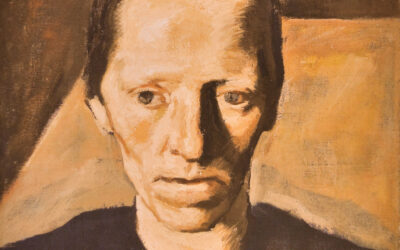
Albin Egger-Lienz – The Nameless
Carl Kraus (Appeared in: And yet there was Art! Austria 1914-1918. Exhibition catalogue, published by Elisabeth Leopold, Peter Weinhäupl, Ivan Ristic’ and Stefan Kutzenberger, Leopold Museum, Vienna 2014)
World War I was not only fought with guns, cannons and bombs but also with an unprecedented flood of images. Mainly they are soldier portraits, depictions of marching troops, sentinels, field masses, fortifications in rock and ice, etc. In Austria-Hungary these were executed mostly by officially designated “war painters” who were part of the propaganda machinery of the Imperial and Royal Press Office.
Within this “trench impressionism”, one artist stands out like an erratic rock with his paintings
“Die Namenlosen 1914” (The Nameless 1914), “Leichenfelder” (Fields of Corpses), “Missa eroica” and “Finale”: Albin Egger-Lienz.
The first peasant from “Totentanz” (Dance of Death), c. 1920/23 (Kirschl Z 561; Bozner Kunstauktionen 29, 19.5.2016, no. 61).
As a late historical painter Egger had already immersed himself in the subject of “war”, specifically in the Tyrolean Rebellion of 1809. His own war experience, in addition to his artistic maturity, now leads him to a new and deeper dimension which intensifies his characteristically plastic-monumental form language to an expressiveness not seen up to this point. These works permeate the collective memory as merciless testimonials of the “primal catastrophe of the 20th century”, similarly depicted in “The Last Days of Humanity” by Karl Kraus, where he also gives a voice to the “simple soldier who is nameless” (K.Kraus).
Whereas, at the beginning, Egger-Lienz deals with World War I in the spirit of “for God, Emperor and Country”.
“The heirs to the throne are dead. Grief spreads its black wings over the country, forces tears in the eyes of the nations and knocks and tugs at all who still have a speck of humanity in them. Like Faust one has to say: the misery of the entire humanity grips us. The heir to the throne and his wife, heirs to the Empire, the power and the love of the nations of the Austrian Empire for the rightful ruling dynasty are dead, shot, murdered by a hired nationalist thug. We are confronted with an event that can be added to the great book of chronicles only with trepidation and horror.” (Extra-supplement in the Allgemeiner Tiroler Anzeiger, 6.29.1914, p.1)
This dramatic news reaches Albin Egger-Lienz, born in 1868 in the eastern Tyrolean town of Stribach, at his home in St. Justina near Bolzano during a time in which he is immersed in his work as usual. But this is also a time of worry since his most important collector, the Viennese restaurant owner Franz Hauer, had died a few weeks prior. The heir to the throne, however, also figures prominently in the biography of the painter since, due to a complete lack of understanding of the artist’s work, he had prevented Egger’s appointment as professor at the Viennese Academy of Fine Arts four years earlier.
“Archduke Franz Ferdinand (killed in Sarajevo) reacted, upon seeing “Totentanz” (Danse Macabre) […] for the first time, with a rare astute remark: “If my soldiers see this, they won’t come along.” This was in 1909 when again, for a second time, a war could barely be avoided. This cost Egger the professorship in Vienna. However, Franz Ferdinand was right. This Egger-Lienz could not be contained. […] He was a non-military person. A being like Delacroix’s rearing horse.” (Georg Paech, Egger-Lienz. Im Sächsischen Kunstverein, in: Dresdner Neueste Nachrichten, 9. 25.1927)
The turmoil after the assassination of the heir to the throne did not prevent Egger-Lienz from traveling to Längenfeld in the Ötztal valley on July 22 to carry out studies for new versions of “Arbeit” (Work) and “Die Alten” (The Old). Not even a week later, on July 28, the inevitable happened.
“Emperor Franz Joseph I has released the following letter and decree […] To my Nations! It was my greatest wish to dedicate the years that I have left by the grace of God to peaceful endeavors and to protect My People from the heavy sacrifices and burdens of war. Providence had a different plan. The heinousness of a hate filled enemy is forcing Me, after many years of peace, to reach for the sword in order to preserve the honor of My monarchy, to protect its prestige and position of power, to safeguard its territories.” (Innsbrucker Nachrichten, 7. 29. 1914, p.1)
The outbreak of the war, which quickly developed inevitably into a worldwide war given the existing European alliances, soon permeated all aspects of life and Egger-Lienz, just as transfixed by it, interrupts his study trip to Längenfelden and returns to his family in St. Justina. While the events escalated, he was, at first, still able to dedicate his time relatively undisturbed to his big compositions “Der Mensch” (The human) and “Die Alten” (The Old). Others, like his fellow painters Max von Esterle and August Frech, were being sent to the front lines in Galicia as early as August 1914 with the Tiroler Landsturm-Regiment II and witnessed one of the first catastrophic defeats of the Imperial and Royal Army during World War I.
“None of us had expected to still have to endure, at our old age, such overwhelming physical and emotional hardships. It is unbelievable what the war destroys. Nevertheless, I have the distinct impression that this is a deserved punishment. So far, we took part in two big battles, half of the soldiers and officers perished [1800 of 3600], our strength diminishes, everywhere the land is being destroyed by us.” (Max von Esterle, letter to Ludwig von Ficker, 9.18.1914)
With the “well deserved punishment” Esterle hinted at a notion popular with intellectuals at the turn of the century. In the very first Futurist manifesto in 1909 Filippo Tommaso Marinetti speaks of war as the “only hygiene of the world”, the inevitable cleansing of a society which is backwards thinking, materialistic and undemanding bourgeois. Other artists had the same believe and enlisted voluntarily to be sent to the front: August Macke (killed in September 1914 in Champagne), Otto Dix (who later became an anti-war painter), Oskar Kokoschka (after his separation from Alma Mahler), Fortunato Depero (Futurist from the Trentino region), to mention a few.
“I can only compare the experience of these times […] to a great amorous adventure. That’s how much it shook me and it made my very being come apart. It is a tremendous feeling of happiness, to be beyond oneself, liberated of oneself. And this is something greater and it is real, not only an idea.” (Ernst Barlach, letter from 8. 29. 1914)
Against the backdrop of these events, Egger-Lienz begins to develop an idea for his first monumental war painting as early as November 1914. It is indeed a “big” subject which in Eggers eyes has always been the basis for “timeless” art.
“‘The monumental form’, the spiritualization of the subject into a symbol; however, without removing the ground which the historical event needs to develop, but rather by considering the subject the stimulating, permeating, form-shaping element.” (Egger-Lienz, letter to Dr. Eisler, 2.26.1917, quoted from Kirschl as well as the letters below)
He clearly envisions this first painting of the “Great War”, the realization of which is not known, as unmistakably patriotic “propaganda painting” and this illustrates how long of a path as painter of the war Egger-Lienz still has before him.
“I’m planning to paint a new, big slab, the biggest yet: ‘The War 1914’, Germany-Austria’s battle ready army; in the middle up front Saint Michael brandishing sword and scale (all gold and in armor).” (Egger-Lienz, letter to Otto Kunz, 11.3.1914)
In Bolzano, in the meantime, the painter is increasingly confronted with the economical consequences of the war since the art market collapsed just like many other things. Exhibition spaces such as the Künstlerhaus and the Secession in Vienna are turned into military hospitals and the loss of his late patron Franz Hauer becomes ever more taxing. Due to his precarious financial situation but also out of a feeling of isolation, Egger even considers moving to Munich, “the right ground” for him and his art. First, however, he wants to wait for the end of the war and finish his series on Creation in Bolzano.
The war continues into the following year and his hope that the spring will bring “the prospect of peace” (Egger-Lienz, letter to Franz Bunke, 12.24.1914) is to repeat itself for several more years.
In fact, every day it becomes more likely for Egger-Lienz to be drafted like others of his age group, therefore, at the end of April he reports to the Tyrolean Standschützen.
“I reported to the Standschützen here on advice of Zeiller [sculptor Ottomar Zeiller] since they will most certainly remain in the country but will be militarily equipped. They made some concessions and the danger of being removed from the Schützenkompanie and sent to Galicia seems to be averted.” (Egger-Lienz, letter to Otto Kunz, 5.10.1915)
Egger’s fear of being sent to Galicia was certainly justified since it was there that the army suffered devastating casualties. For instance, the fall of the fortress Przemysl on March 22, 1915 resulted in the arrest of nine generals, 2,593 officers and 117,000 soldiers, among them Max von Esterle and August Frech who spent the next six years imprisoned in Siberia. So many paintings didn’t get painted because of this, think how much of Egger-Lienz’s work would not exist if he had suffered the same fate…
In May the “information sheet of the k. u k. Standschützen-Ba[taill]on Bozen” for Egger-Lienz was already filled out.
“Rank: Standschütze / Name: Prof. Egger Albin Lienz / Year of Birth: 1868 / Religion: Cath. / Status: Married / Occupation: Acad. Painter / Education: Elementary school – Academy of Fine Arts, Munich / Place of Birth: Striebach / Jurisdiction: Bolzano / Enlisted at the shooting club: k.k.Hauptschießstand Bozen Erzh. Eugen / Military experience: II. Landsch. Reg. / Obtained Rank: 1. Res. / Enlisted as Standschütze on: May 19, 1915 / Designated service: 1 Comp. for border protection on May 20, 1915 / Service: Field service”
The “Personnel file” can be found in the “Subdivision of Registry” of 1891.
“Hair: brown / Eyes: green / Eye brows: brown / Mouth: regular / Chin: regular / Face: oval
/Special Features and possible ailments according to assessment: physical weakness / Spoken language: German / Written language: ditto / Height in meters: 1.68 / Shoe size: 12”
Egger-Lienz arrives with his unit at the border on Lake Garda on May 20, first in the village of Campi northwest of Riva, and from there to the nearby mountain fortress Tombio. Two days after the arrival, while the painter has been assigned to trench work and the camouflaging of casemates, Italy declares war on Austria-Hungary.
“Italy’s declaration of war. Vienna May 23. […] On May 4, Italy informed the
Austrian-Hungarian government about the serious reasons why, believing it was well within its right, it had declared its treaty of alliance with Austria-Hungary null and void after it has been breached by the Austrian-Hungarian government. […] The king considers himself at war with Austria-Hungary starting tomorrow.” (Bozner Zeitung, 5.25.1915, p.1)
Egger-Lienz sends his wife an account of his stay at the fortress Tombio:
“I spent 14 days with the Standschützen in the line of fire on the front lines […] in the middle of cannon thunder. Fire was also returned from our fortress. However, the garrison I belong to did not have to intervene. But everybody was on alert. Our borders are so well secured that the Italians will never be able to cross without being forced to retreat bloodied.”(Egger-Lienz, letter to Laura Egger-Lienz, 6.14.1915)
After these two weeks, a military physician certified a “heart condition when walking uphill” – the fact that he was the most prominent Tyrolean artist was undoubtedly helpful – he was declared unfit to serve and was reassigned by the Ministry of War as artistic advisor to the War Welfare Office in Bolzano. “I will only do artist work [as] a civilian, this way I can contribute most to the homeland.” (Egger-Lienz, as above)
These patriotic “artistic services” consisted primarily in designing war postcards as well as illustrations for the “Tiroler Soldatenzeitung”, with the objective, which did not change under the direction of Robert Musil (July 1916 until April 1917):
“It must remain cheerful, with dry humor but enough seriousness, with hate toward the enemy and love for emperor and homeland. (Tiroler Soldatenzeitung, 8.6.1916, p.3)
For the most part, it was a trivialized depiction of the subject matter which was similar to the many “war painting exhibitions” put on by the Imperial and Royal Military Press Office starting in the fall of 1915, typically: Farewell, Vigil in the Dolomites, Resting Guards in the Dolomites, Machine guns at an Elevation of 3000 meters, Tyroleans in the Line of Fire, Field Post high up in the Mountains, The Oldest and The Youngest, Adoration of an Imperial Bust, and so on. The artist references back to some of his older works, for instance to “Ave Maria nach der Schlacht am Bergisel” (Prayer after the Battle at Bergisel) (1894/96) and “Haspinger Anno Neun” (Haspinger Anno Nine) (1908/09). In some of his works he also applies his parallelism in Hodler’s sense as in “Neuschnee in den Dolomiten” (Fresh Snow in the Dolomites), where the soldiers, who are carrying beams, seem to perform a dance.
He gives the marching “Helden” (Heroes) a rhythmic effect, however, with a much stronger martial overtone, in the painting of the same title as well as in the lithograph “1915” which the artist executes at the behest of the Gesellschaft für vervielfältigende Kunst in Vienna.
“An invincible power, like an impenetrable wall, the Austrian and German people in arms drive the enemy back. I have to forgo the intimate characterization of the people if I want the “symbolic”, which is always at the heart of the subject, to have its effect. Determination, strength, confident step, etc.” (Egger-Lienz, letter to Heinrich Hammer, 11.5.1915)
The painter is able to free himself from this forced style of the “Helden” (Heroes) when he spends time as a “civilian war painter” in Folgaria near Rovereto in January/February of 1916, where he depicts Austrian fortifications in rocky mountain landscapes with a supple balance of construction and spontaneity. In May he paints the deployment of Austrian troops at the Castello del Buonconsiglio in Trento and later witnesses the Austrian offensive near Aldeno, south of Trento.
“Our successful offensive against Italy […] Further Italian positions conquered. 12 officers and more than 900 soldiers captured, 18 canons and 18 [below 1800 are mentioned] machine guns seized. Italian lies about the ‘horrible and immense’ losses of our troops to downplay their own retreat.” (Bozner Zeitung, 5.19.1916, p.1)
Egger-Lienz’s impressions, which he writes down in his essay Das Kriegserlebnis des Künstlers (The war experience of the artist), are completely different. For the horrors of the fields of the dead he finds no words, only dashes.
“The battlefields on the vast mountaintops of the Col Santo and Coston resembled a tilled fallow field; all traces of human activity are razed. Trenches, fortifications, where are they? It was a massive storm that erased everything. There is a twisted gun, a postcard – there – a steel helmet, and a – – a – – – “ (Frankfurter Nachrichten und Intelligenzblatt, 8.1.1916)
Out of these immediate, formative experiences Egger develops, retreated in his studio, his compositions “Die Namenlosen1914” (The Nameless 1914), “Leichenfelder I – IV” (Fields of Corpses I – IV), “Missa Eroica” and “Finale”.
In his Egger-Lienz monograph, Wilfried Kirschl recounts in detail the origin stories of these works, how the artist develops one work out of the other and how, with “Finale” he paints something like a final exclamation point that cannot be surpassed.
With the monumental (243 x 475 cm) painting “Den Namenlosen 1914” (The Nameless 1914), which he reworked several times and which originally was titled “Uhnow 1914”, referring to the harrowing battles in Galicia, the artist seems to sum up all his war paintings, starting with “Kreuz” (Cross) (1898-1901), then “Haspinger Anno Neun” (Haspinger Anno Nine) (1908/09) and “Helden” (Heroes) (also: Der Krieg [The War]) (1915/16) and finally to the one just prior to the last painting, “Uhnow 1914” (1915). At the same time Egger is now able, through his work process which is characteristically lengthy and frequently continues over several years, to consolidate all his achievements into an exemplary body of work. The parallelism of the figures as well as the diagonal structure, which emphasizes the dynamic effect, can be detected in rudimentary form in “Kreuz” (Cross) and later fully developed in “Haspinger”. Any softness in his shapes, all conventionality and clichés, which can occasionally be detected in the works of his middle period, now give way to an uncompromising expressionist depiction. Egger himself is convinced that “my intention has never before been in such clear harmony with my artistic ability” (letter to Dr. Eisler, 2.26.1917). And in a note in pencil he conveys what his fundamental concerns in “Den Namenlosen 1914” (The Nameless 1914) are.
“Gasping hardship of a person who is tested to the limits of his strength – it is ‘the act’ that one day will remind us and our grandchildren of the horrific whiff of our times.”
When the painting is shown in 1917/18 at exhibitions in Bolzano, Munich, Innsbruck and Vienna it was widely seen as “sensation”.
“Even within this [restricted space] we get caught in the horrific waves which engulf us in rhythmic repetition like a gigantic storm surge. In each face there is part of the wild elemental force that is about to break loose, each movement enthralled by the larger rhythm, in each back a wave as part of the giant surge which must materialize behind the high horizon and appear as soon as the first wave subsides!” (Josef Garber, Die Kaiserjäger im Weltkriege. Zur Ausstellung in den Stadtsälen, in: Allgemeiner Tiroler Anzeiger, 1.31.1918, p.1)
Emperor Karl personally attends the exhibition “Die Kaiserjäger im Weltkriege” (The Kaiserjäger in the World War) on February 2, 1918 in Innsbruck.
“The Emperor conversed with the artists who were standing next to their works, especially the ones he was already familiar with […]. In front of his monumental painting Professor Albin Egger-Lienz had the opportunity to summarize his primary thoughts and basic motivations for His Majesty.” (Österreichische Illustrierte Rundschau, 1918, no. 47, p.919)
Was the last emperor more perceptive to this painting than the heir to the throne was upon seeing “Totentanz” (Danse Macabre) ten years earlier? In any case, it was acquired by the Museum of Military History an entire decade after the death of the artist (1926).
In even more drastic manner than in the forward charging anonymous soldier-machinery in “Den Namenlosen” (The Nameless) the “horrific whiff” of war finds expression in the stacked corpses of the “Leichenfelder” (Fields of Corpses) and “Missa Eroica” (which was later cut up by Egger) and especially in the gruesomely distorted dead bodies in “Finale”. The artist shows these works publicly only after the war; “Finale” is shown for the first time in 1919 in Zurich. Again, it is received with great acclaim, and even in France Egger’s war paintings are greatly admired.
“Does France have a war painter of the same stature as it has Barbusse or Roland Dorgelés in literature? I can’t name any. […] but Austria has one who captured the horror of the slaughter and whose earlier works prepared him for it: A. Egger-Lienz […]. The last two works are, in my opinion, the greatest and most beautiful. ‘Missa Eroica’ shows us a bomb crater, lost, abandoned men, distorted in pain and one with the earth. And ‘Finale’ follows […], in greenish, uniform tonality, erased, smudged like death, the most intense expression of futility, the absurdity of unrestrained murdering.” (A. du Brief, Egger-Lienz, in: Journal du Peuple, Paris, 11.5.1927)
In contrast to the works of Otto Dix or Georges Grosz, and also to the drawings of Klemens Brosch, to stay within the context of Austrian artists, Egger does not intend his paintings to be an indictment even if their effect is as such, comparable to Gerhart Frankl’s series “In Memoria” (1964/65) which is dedicated to the starved and murdered prisoners of the Nazi concentration camps. It is telling that the war memorial in Lienz, which he designed based on his prior war paintings, was vehemently rejected at the beginning. It is also significant that during an Egger-Lienz exhibition in the Viennese Gallerie Welz 1940/41 his work “Finale” was shown in a separate room and was not included in the catalogue, because it was feared that it might cause an uproar due to its latent subversion of the military .(s. Kohlfürst 1999).
“Beyond the disgrace of war goes the one of the people who no longer want to hear about it, who tolerate when it is war but not that it was. Those who survived it have outlived it, and although the masks are still on on Ash Wednesday they don’t want to be reminded of each other.” (Karl Kraus, The last Days of Humanity, Vienna 1922, preface)
Egger’s examination of the war does not end with the war. It leads him, following “Totentanz Anno Neun” (Danse Macabre Anno Nine), to “Blinden” (The Blind) (1918/19) with the theme of accepting fate and depicts the further intensification of human hopelessness, while “Protest der Toten” (Protest of the Dead) (1920-25) represents an “albeit pacifist but entirely non tendentious protest of the victims of war against the war itself” (Adalbert Muhr, Conversation with Egger-Lienz, in: Neues Wiener Journal, 8.22.1925). With “Kriegsfrauen” (War Women) (1918-22) the artist highlights another for the most part ignored aspect: It is the disillusioned realization that the war required them to endure it without having a voice; in their sorrow for their husbands and sons, lost on the battlefields, the women are hardened into wooden masks, contorted with pain.
More texts on Egger-Lienz
Albin Egger-Lienz (1868–1926)
Many labels have been attached to Albin Egger-Lienz: late historical painter, peasant painter, regional artist, blood and earth painter … What cannot be overlooked, however, is the fact that Egger, above all else, was continually searching for new forms of expression …
Fundamental Life Story
He needs for his work … the entire circle of life: “Love (procreation), the mother, the children, the struggle, the regret and awareness … It is the mind of a painter who, inspired by the symbolist zeitgeist, wants to provide a setting for fundamental questions of existence through powerful images …


